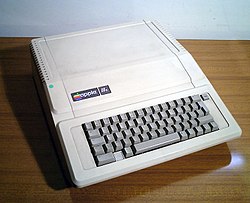Apple IIe
| Apple IIe | |
|---|---|

|
|
| Manufacturer | Apple |
| Presented | January 1983 (USA) |
| Discontinued | November 1993 (USA) |
| Recommended sales price | US $ 1298 (approx. 3500 to 5000 DM) depending on the equipment |
| CPU | 6502 / 65C02, 1.020 MHz |
| R.A.M. | 64 kB (up to 1 MB and more) RAM |
| OS | ProDOS 8 |
The Apple IIe was a further development of the Apple II , which, after the failure of the Apple III, was developed by Apple within a very short time as a "loss stopper" and published in early 1983. It had 64 kB of RAM installed as standard and essentially behaved like an Apple II + with an Apple II language card already installed . An upgrade (by means of a single plug-in card) to 128 kB RAM, Videx-compatible 80-character display and doubled graphic resolution was already provided for in the basic device and was soon carried out by almost all users.
For the first time in the Apple II series, it was possible to input and output lowercase letters without upgrading; the keyboard was able to generate all 7-bit ASCII characters including all control characters, and in the German version for the first time also German umlauts which were coded according to ISO 646 . With the non-American models, you could choose between American and national keyboard layout and character set using a switch under the keyboard. From a software point of view, the switchover was completely transparent, unlike with the IBM PC, no drivers or the like were required.
In contrast to the Apple II / II +, the keyboard of the Apple IIe could be expanded with a number pad; it was also the first in the Apple II series to feature the Open Apple keys from the Apple III and the Solid Apple key (later renamed "Command" and "Option" on the Macintosh ). Since no ASCII code could be assigned to these keys, they were wired in such a way that, from a software point of view, they appeared like the two fire buttons on an Apple joystick.
The IIe consisted of fewer components and was therefore no more expensive than the Apple II + despite its improved properties, but at the same time brought Apple significantly more profit. As a result, production of the II + was stopped immediately after the IIe was released. Since several larger ASICs were used in the IIe instead of the large number of small standard ICs of the older models, the number of Apple clones was reduced because their manufacturers could not purchase these ASICs and in-house developments were correspondingly expensive; However, this also means that, unlike the Apple II / II +, a defective Apple IIe can no longer be easily repaired today, as these ASICs are no longer available.
Initially, Apple DOS , which was taken over from the older models, served as the floppy operating system, followed by Apple ProDOS from late 1983 .
The Apple IIe was a huge success, with an average of 60,000–70,000 computers sold per month in 1983.
In 1985 it received another hardware upgrade, known as "Enhanced IIe": The MOS 6502 processor was replaced by the WDC 65C02 , it received a new character generator that could also generate graphic characters , and two firmware ROM chips were used replaced by new ones. This update eliminated several known errors in the firmware and made it more compatible with the Apple IIc and, to a lesser extent, with the old Apple II original model from 1977, whose mini assembler and step and trace commands were now available again. Apple also sold update kits with the four required ICs and a new type label, so that users of the older version could upgrade their device to the "Enhanced IIe" themselves or in an authorized workshop. The "Enhanced IIe" can be recognized by the switch-on message "Apple // e", the older version shows "APPLE] [" or, if the German character set is activated, the rather strange "APPLE ÜÄ". An Enhanced IIe and 128 kB RAM are the minimum equipment required to run practically all 8-bit Apple II programs. This does not apply to the Apple IIgs -specific.
In 1986 a new version appeared again, the "Platinum IIe", which did not bring any innovations in terms of software, but offered a more modern housing design, further reduced the number of chips (which reduced the price) and had an already built-in number block. In Germany, however, this computer was no longer offered because Apple relied on the Macintosh there . This version was manufactured until the end of 1993, making the Apple IIe the longest-produced computer model in Apple's entire history. A few devices are still in use today by private individuals and in schools as a demonstration model.
See also
- Apple CP / M was the CP / M version for an Apple II that was equipped with a Z80 plug-in card.
- Visicalc the first spreadsheet program for the Apple II and other personal computers .
- Apple Lisa was the successor to the Apple IIe and the forerunner of the Apple Macintosh , it was on the market from January 1983 to 1984. Lisa is considered to be one of the first PCs to have a mouse and an operating system with a graphical user interface.
- The Apple IIc ("c" for Compact) was the fourth model in the Apple II line and was Apple's first portable computer (1984 to 1988).
- In September 1986 the Apple IIgs was introduced as the successor to the Apple IIe. It was the fifth and last model in this series.

